19 Applied thermal biology
I am not mechanical, nor am I a tinkerer. Huey’s First Law of Tinkering is that anything I take apart stays apart. Nevertheless, even I can occasionally apply my academic knowledge of thermal biology to real world problems, thereby making life more thermally pleasant.
I’ll give three examples from diverse venues (Kalahari, Texas, New England).
19.1 How hot is hot? Part I.
Deserts are playgrounds for biologists. Because life there is far less complex than in a tropical forest, key biological patterns and interactions are relatively easy to detect and study. Of course, life there can be physically challenging for organisms (including biologists). Temperatures can be dangerous, water is scarce, and food is often limited. Not surprisingly, biological adaptations of organisms for surviving heat and aridity are often conspicuous.
There is a flip side to deserts. Then rains do come, the once-dry tracks can suddenly become muddy quagmires or even flooded, making driving difficult or impossible. Being stuck in the mud is unpleasant and not recommended.
Still, heat dominates one’s impression of deserts. One July day at midday, Art Dunham and I were walking on a sandy bank of the Rio Grande in Big Bend National Park, where we were studying aging in a local lizard. The air enveloping us was hot. The white sand at our feet reflected and emitted radiation. I was beginning to feel overheated when Art suddenly asked,
“Do you know how to tell whether it is a hot day in the desert?”
Art’s question struck me as superfluous. Hot is obviously hot. Anyone who needs a quantified answer can check a thermometer (Note: many herpers routinely carry thermometers or thermocouples for taking body temperatures of lizards). I don’t recall how I responded to Art’s question, but I suspect I was snide. After all, I was hot.
But Art responded,
“Put out your arm with the palm of your hand facing the sand. If it is a hot day, the bottom of your hand will feel warmer than the top of your hand.”
I put out my hand, and the bottom of my hand was unquestionably hotter than the top. As judged by Art’s criterion, this was a hot day, confirming my subjective impression!
Art didn’t need to explain the biophysics. The skin temperatures of the top and bottom of my hand were governed in part by my own metabolic heat production plus any heat absorbed via convection from the hot air. Moreover, the top of my hand absorbed additional heat via short-wave solar radiation from the sun, whereas the bottom of my hand gained heat by absorbing radiation reflected off the sand and by infrared radiation emitted by the hot sands at our feet. The magnitude of emitted IR radiation is proportional to the sand’s surface temperature raised to the FOURTH power. Because the sand along the Rio Grande gets blistering hot at midday in summer, it emits massive IR loads. Overall, the heat gain from IR below exceeds that from short wave radiation above, so the bottom of my hand was relatively hot.
It is one thing to use a textbook or computer to study the biophysics of heat transfer, but quite another to experience that biophysics with your own bare hands. Art had given me a teaching moment.
19.2 How to make not-hot beer
When Larry and I arrived in the Kalahari in late November 1969, we were just about out of money, and our remaining funds would be uncomfortably tight until Eric came in January (summer). Beer became an infrequent luxury, and what few beers we had were inevitably warm as we had no refrigeration.
When Eric finally arrived, we could suddenly splurge on beer and other necessities for life in a desert in summer. But because we still had no refrigeration, our treasured beers were inevitably warm.
One day Eric told us about his days studying lizards in the deserts of western North America. He had suffered from the lack of cold beer, and he could get cold beer only when passing through a town. Eric was a skilled tinkerer, and he tried desperately to figure out how to cool beer in deserts. One afternoon (when he was probably suffering from heat stress, he even tried briefly dipping a beer can in alcohol, then hoping that evaporation would cool the can. This attempt failed for obvious reasons – but give Eric points for trying.
Eric persisted and eventually derived a technique that worked. He wrapped a beer can in a paper towel or toilet paper, soaked it in water, and placed it in a shallow pan with water. The water in the towel would evaporate and pull heat from the can. Next, the towel’s water would be replenished by wicking from the pan below. This cooling process continued as long as water remained in the pan.
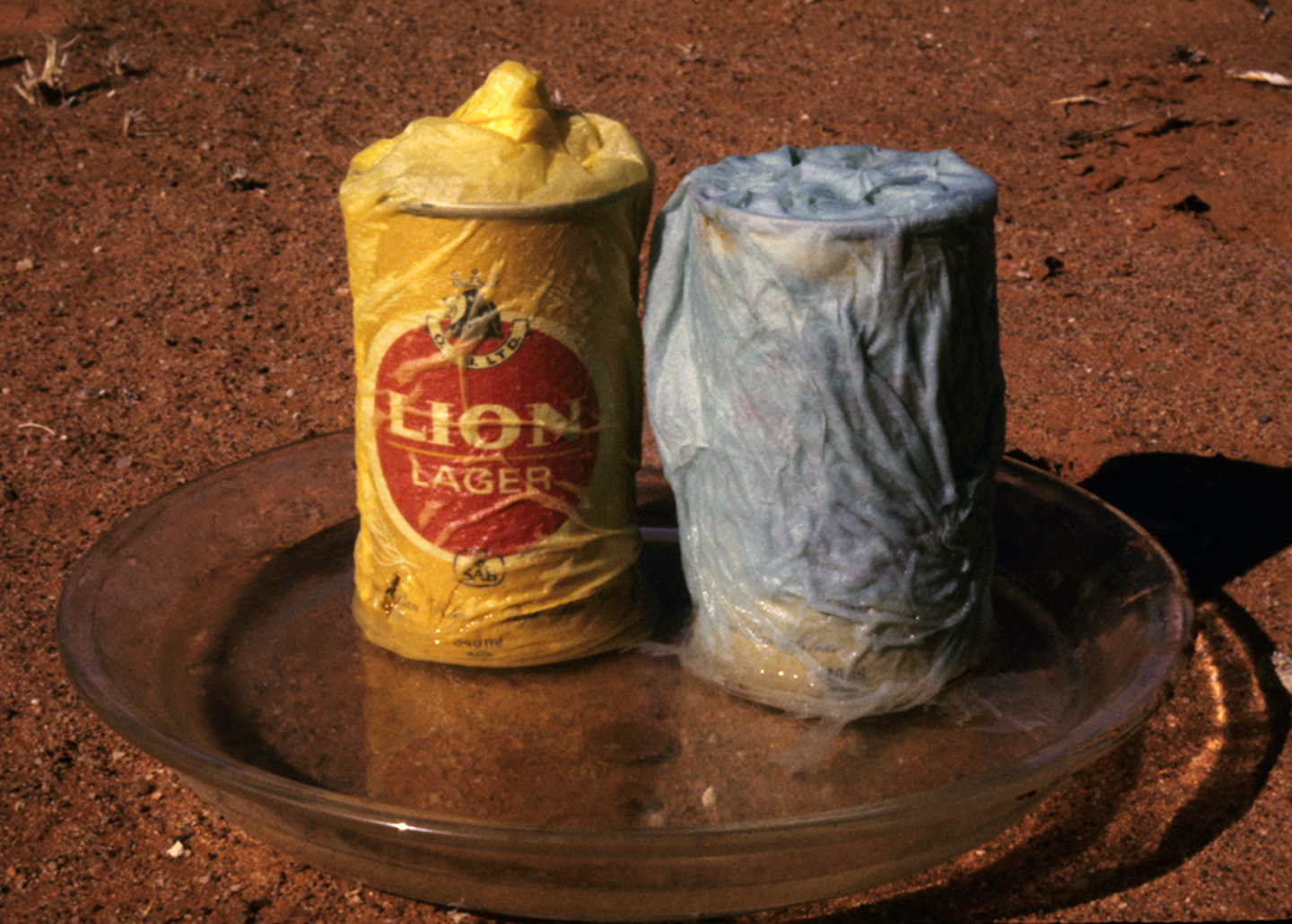
We called this “not hot beer.” It wasn’t ice cold, but it was below ambient temperature. We later discovered that if we left the pan at night, on top of the Land Rover, the beer would be almost ice cold by the next morning. Relatively high wind speeds on the top of the Land Rover probably speeded evaporative cooling, and additional heat would be lost by radiation to the cold night sky.
Of course, cold beer was no appealing at sunrise, even in mid-summer. But we could retrieve the cold beer cans and pack them closely together in a down sleeping bag that we kept in the shade. By noon, once we’d finished ‘weighing-measuring-and-pickling’ the lizards from our morning’s hunt, we’d each polish off a not-hot beer and congratulate ourselves for our insights into thermodynamics. Remarkably, any remaining beers (carefully sequestered in a sleeping bag) would still be relatively cool even by dinner. Life in the desert was now good.
We used the same technique to keep meat cool for a few days or keep captive lizards alive. We’d just put the meat (lizard) in a big gallon jar and warp it with a wet towel. ‘Not-rot meat,’ ‘not-dead lizards.’
Sharing not-hot beers with Larry and Eric was special. And our late-afternoon not-hot beers were a reward for a day well spent and gave us a quiet moment to relax and anticipate an evening of geckoing to come.
19.3 How hot is hot? Part II.
As noted above, sand temperatures in deserts can get very hot. But “problems” sometimes can present opportunities.
On my last trip to the Kalahari (2018), I was joined by Barry Sinervo, Don ‘Naja’ Miles, and Suzanna Clusella-Trullas, Sebastian Kirchhov, and Anthony Gilbert. Barry, who had been a grad student and postdoc with me, had a debilitating cancer but had long looked forward to visiting the Kalahari with me. Barry truly loved animals (especially lizards) and science. I was delighted to show him the species and sites he had read about for years. Our Kalahari experiences shared with good friends were healing for him. Even so, he was suffering but never complained. His parents were from Finland, and Barry adopted the Finnish concept of ‘sisu’ – stoic determinism and extraordinary perseverance.
We headed to our Aarpan site, a red-sand area with stabilized, longitudinal dunes. I’d been there many times over the years. It was a great site for Nucras tessellata, the most spectacular Kalahari lizard. Unfortunately for us, Nucras is a high-temperature lizard and becomes active only late in the morning when ‘good’ diurnal lizards (and hopefully herpers) should be retreating to shade.
On one hot day, Barry pulled out an IR ‘gun’ and took the temperature of the sand (64.5 °C, 141 °F). He announced, “Let’s make solar quesadillas!” Chef Barry pulled out a skillet, placed it directly on the hot sand for a few minutes, and then added a tortilla topped with cheese. We were soon enjoying Quesadillas a la Kalahari. Field ecology meets applied biophysics. No fuel was used, no CO2 was produced. A great meal was had by all.
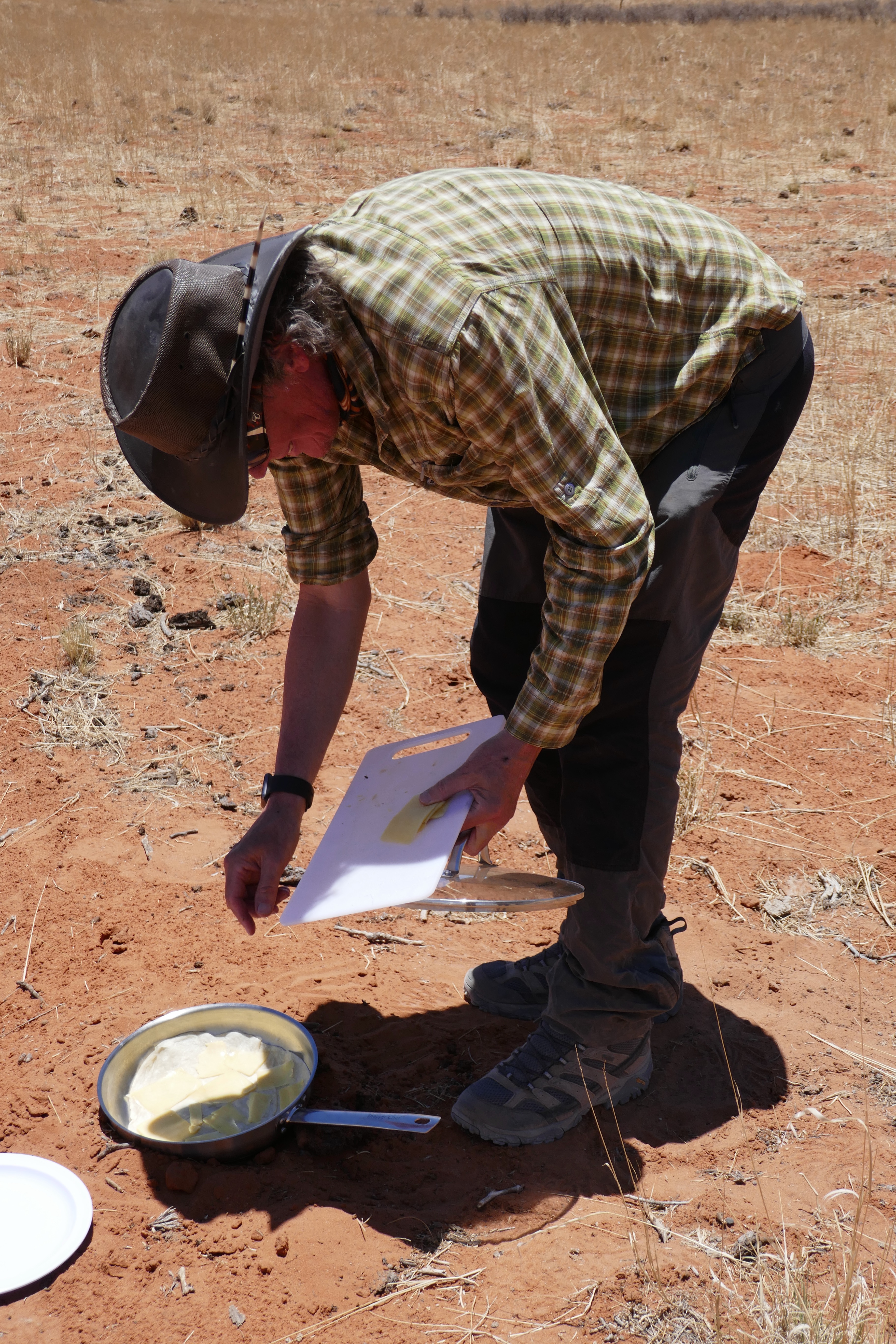
19.4 Learning from ground squirrels
We continued making ‘not-hot beer’ on the ’75 trip, but by the ’81 trip, portable refrigeration had evolved. We purchased a Coolatron, which is an insulated box equipped with a Peltier device that, when given power, would magically heat or cool the interior. We’d plug our Coolatron into the outlet for the cigarette lighter on our truck, turn the dial to cold, and enjoy cold drinks whenever we wanted. We did need to be patient, as the Coolatron was tediously slow to heat or cool.
Near the end that trip in ’81, Al Bennett, Henry John-Alder, Ken Nagy, and I spent one day (sunrise to sunset) lounging in the shade of a sprawling acacia tree in the dry bed of the Nossob River, which defines the border of Botswana and South Africa. We watched Cape Ground Squirrels, which use their fluffy tails as portable parasols.
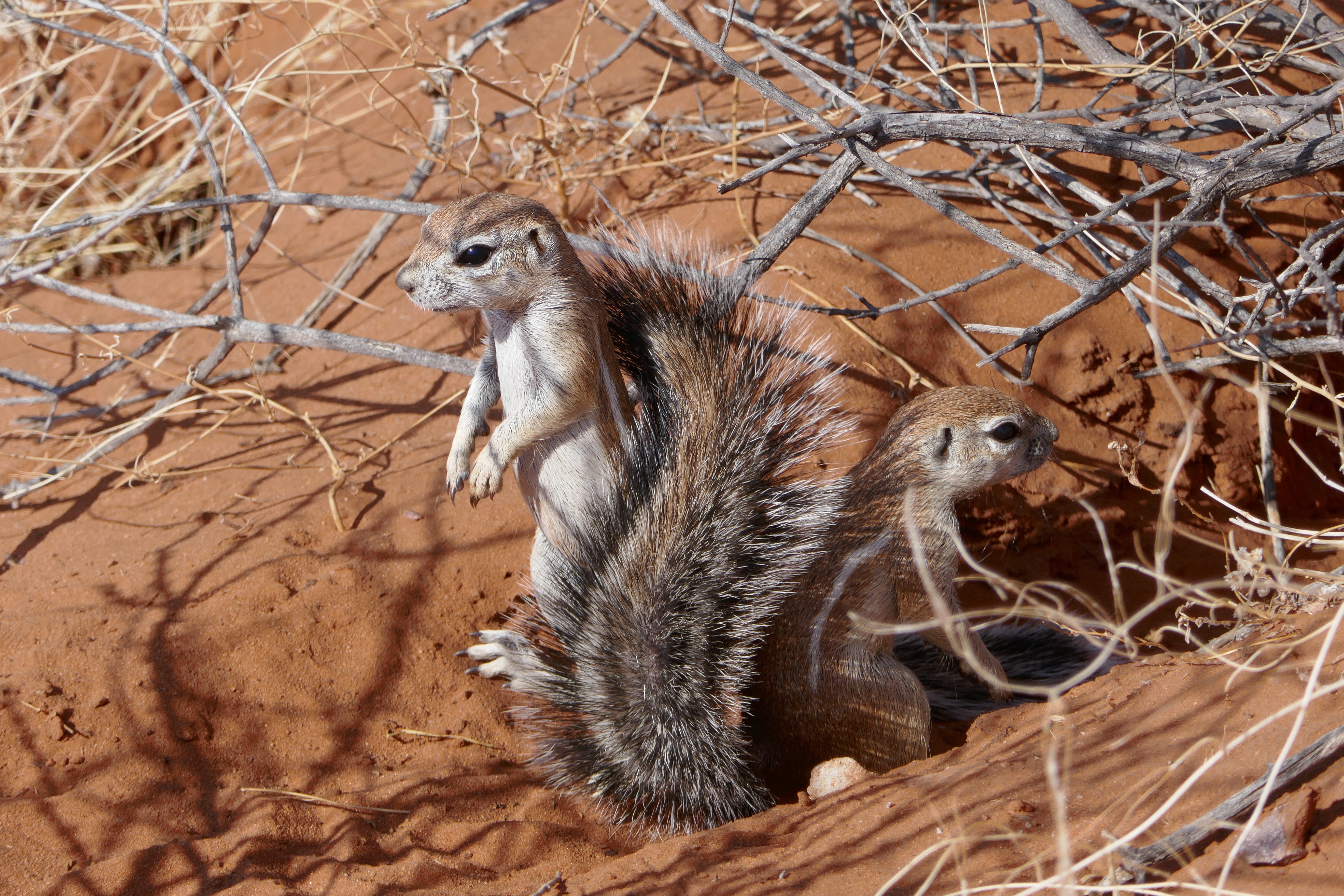
This was a classy field study, if I don’t say so myself. The acacia provided deep shade. Moreover, we relaxed on lounge chairs, played the Rolling Stones (Tattoo You) on the tape deck, and had cool drinks (only soft drinks!) whenever we wanted.
Our goal was to determine whether the shade from the parasol tail increased the potential activity time of these squirrels, as did a similar (though much smaller) tail of Antelope Ground Squirrels in the southwestern deserts of the USA.
Our plan was to scan the river bed every 15 minutes and record the number of squirrels with tails up versus with tails down. The Warden of the park had collected two squirrels for us. We skinned them, draped their skins over wire skeletons, making squirrel ‘manikins.’ We positioned one with its tail up (providing shade) and the other with its tail down. We then measured the temperature inside each manikin every 15 min. If the tail was an effective parasol, the squirrel with its tail up would have a lower temperature than the squirrel with its tail down.
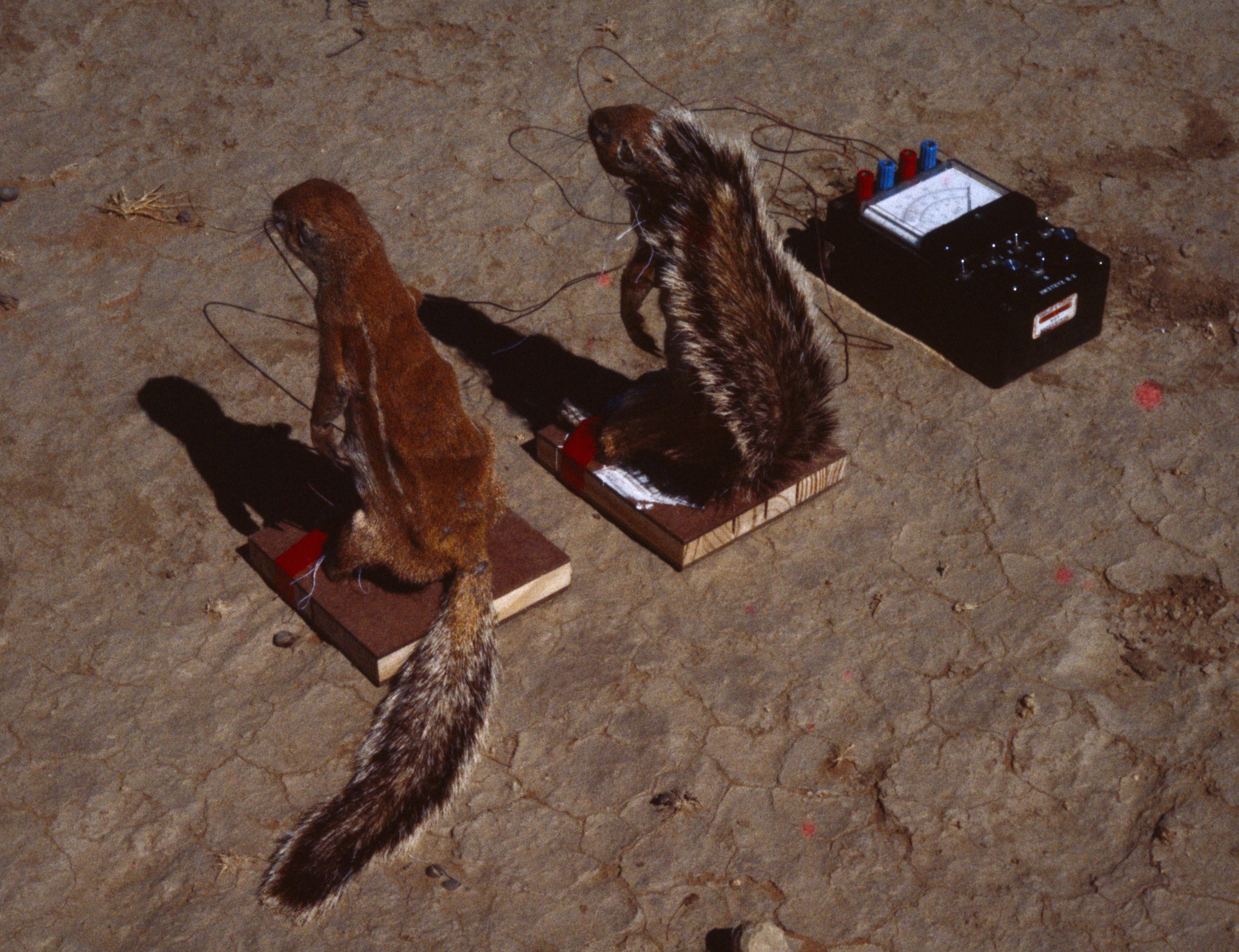
The squirrels and weather cooperated beautifully, and we spent the day periodically counting squirrels (tails up versus tails down), recording the operative temperatures of the two manikins, and laughing a lot. We found that the parasol tails could effectively double a ground squirrel’s activity time during the day. This one-day effort became in a paper in Physiological Zoology (Bennett et al., 1984). I do like one-day projects!
Our project was ‘slothful’ data collecting at its best. And the Coolatron, lounge chairs, and tape deck were heroes of the day. Only one of us needed to venture out every 15 minutes to record operative temperatures, and the others graciously supervised from the shade.
Unfortunately, we failed to anticipate the consequences of running the Coolatron and tape deck throughout the long day. When it was finally time to drive back to the Park Headquarters, our truck no longer had sufficient juice to start. Oops. Fortunately, the surface of the dry river bed was solid and the truck had a stick shift, and we could push the truck and jump start it back to life.
Even before this confirmatory study, we realized that could learn a biophysical lesson from the ground squirrel’s behavior. So when we were following individual lacertids as part or a different project, most of us used parasols and thus avoided being directly exposed to the sun. Most of us, but not Al Bennett. For Al, style mattered more than comfort, and he wouldn’t give up his beloved Machiavelli cap!
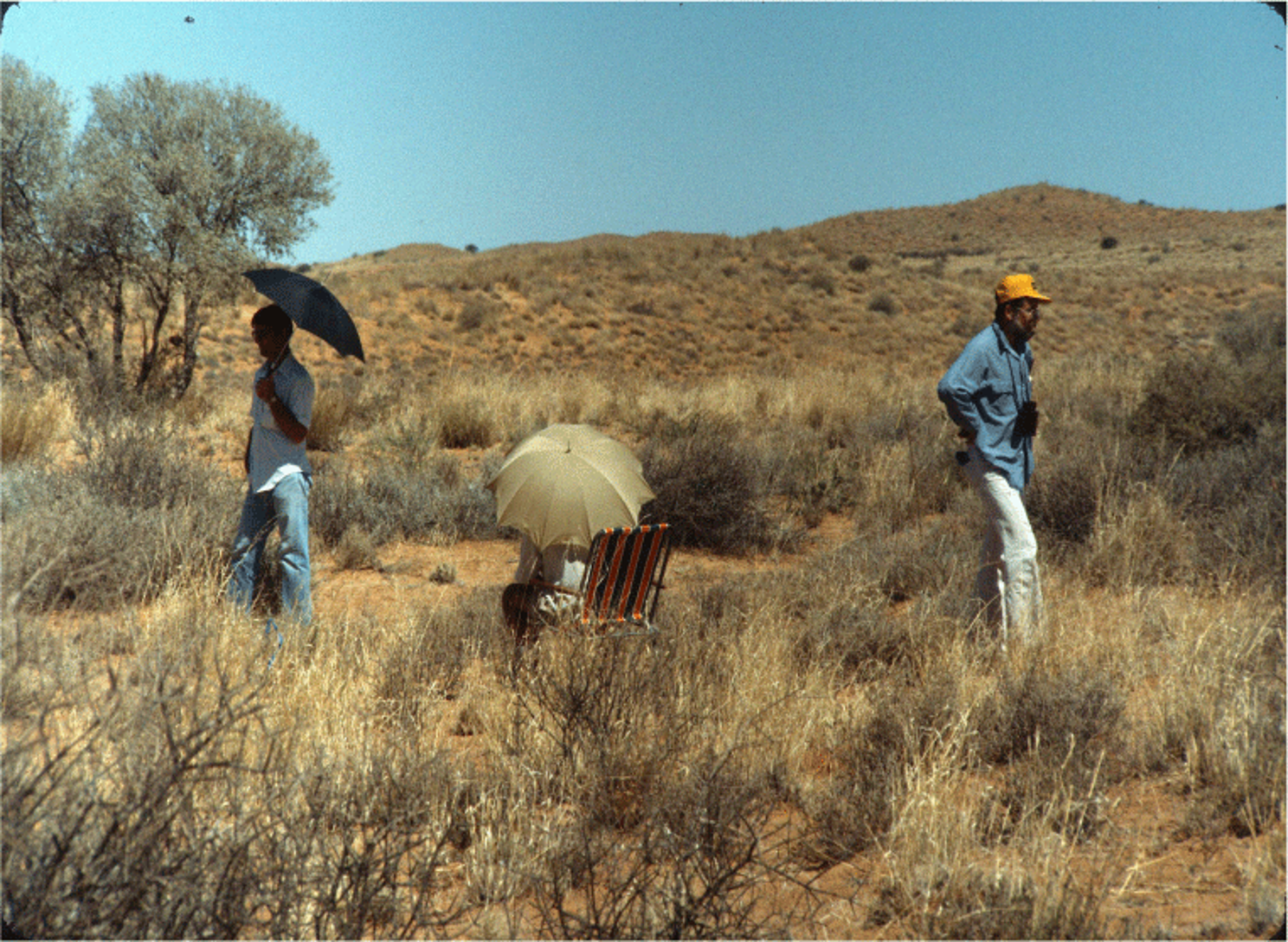
19.5 Technology in the desert!
When we rented vehicles in 2014, technology had advanced even further. Our rented Land Cruisers came equipped with portable coolers that had a dedicated battery. Even if those auxiliary batteries ran out of juice, the trucks could still start. These coolers were great for keeping meat and other perishables, and they kept beer and other drinks ice cold. Camping in the Kalahari had become more civilized. Degenerate perhaps to an old timer, but pleasantly degenerate.
19.6 From hot to cold
Only hardy souls go camping in Cape Cod in late Autumn, but Carolyn and I decided to do so in November 1973. We found one open campground and had it all to ourselves! We soon learned why – Cape Cod in late November is rather cold for camping. Nevertheless, we were committed. We set up our tent, cooked dinner, and quickly retreated to our tent for the cold night ahead.
Just getting into cold sleeping bags was chilling. The rip-stop nylon liners were cold and sucked the warmth out of our bare legs. Eventually, we cold warm our bags, but those first few minutes were decidedly unpleasant.
We spend the next day exploring the Cape and eventually headed back to our campsite for a second night. We were not looking forward to getting back into our cold sleeping bags. But just a few miles from our campsite, I spotted a laundromat.
Applied thermal biology came to the rescue once again! We tossed our sleeping bags in a tumble drier, let them warm for a few minutes, shoved them into stuff sacks, and drove quickly to our camp. There we unstuffed our still warm sleeping bags and hopped in. So nice!
A PCT or AT ‘thru hiker’ might well scoff, as is their earned right. But we were warm, happy, and smug.